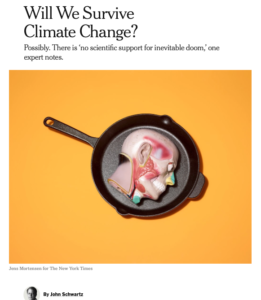As someone deeply committed to climate change mitigation and reversal, there are few things that annoy me more than climate scientists who are oblivious — I mean completely oblivious — to social and political dimensions of climate change. So when brilliant climate scientists, such NASA Goddard Institute for Space Studies’ Kate Marvel tells me how “it’s worth pointing out there is no scientific support for inevitable doom” (https://nyti.ms/2zkh7Fh), I literally want to pull my hair out; and not only because I have been breathing climate change into my lungs for the past two weeks (https://nyti.ms/2DvEcHY).
“Inevitable”? Well, no. But the problem with Dr Marvel’s claim is that her science will tell us absolutely nothing — zip — about the kinds of things we need to know in order to determine whether or not we are doomed. Climate science tells us nothing about political, social, and cultural currents. It tells us nothing about how or even whether we can elect enough policy makers to mitigate climate change in time. So, yes, theoretically today we could adopt and implement policies that will stave off disaster. But will we? Will it be enough? Will it be in time? Climate science has absolutely no answers to these questions. Which is why we must walk to the other side of the campus, to Political Science, Sociology, Social Policy, and Economics, where very bright women and men work tirelessly on other sciences (yes, sciences, social sciences) to find the cracks through which climate change mitigation has a chance of prevailing.
“Inevitable”? Not even Dr Marvel’s science promises 100 per cent certainty. So let me simply identify — scientifically — three of the leading headwinds:
- The policy-makers are paid employees of the carbon emitters. Nowhere is this more true than in today’s Washington and in many of the United States’ capitals. But it is also true even in nations whose very shores and air are currently experiencing the consequences of climate change. Scientifically, we can measure how much it costs — not much — to turn a district into a climate change denying district (see http://opensecrets.org).
- Gorgias’ “Fine Art.“ Gorgias is the rhetorics teacher in Plato’s early dialogue, The Gorgias, who claims he is able to teach anyone how to convince non-experts that he or she is an expert. Plato’s point is that until citizens are equipped to distinguish BS from non-BS they will have to rely upon “experts” who, presumably, will break roughly 50-50, on the BS scale. Nationally, as spending on education per capita has declined, spending on prisons has risen proportionally (https://www.universityofcalifornia.edu/infocenter/california-expenditures-corrections-and-public-education). Which means that ever fewer among us are equipped to differentiate Gorgias’ “fine art” from real scholarship.
- Short- and Long-Term Interests. Social scientists have known for some time that wealth, education, and security give social actors the luxury of reflecting and planning for a world beyond the present. As social actors are pushed ever closer to the line — on employment security, healthcare, housing, education, and old age expectations — they are compelled to spend more of their time planning for the present. Globally, social actors are everywhere losing the battle over long-term interests. Not simply income inequality, but war, famine, ethno-religious nationalism, many of which are secondary effects of climate change, are forcing social actors to devote more of their attention to the here and now.
“Inevitable”? Well, no. But the problem is that science, narrowly defined, as Dr Marvel defines it, has absolutely nothing to tell us about the likelihood of resolving this problem. Which gives us some idea as to where we ought to be throwing massive resources: into protecting public institutions from private self-interest, transferring wealth and its benefits back down the income hierarchy to the working families who generated them, expanding and lowering the consumer costs of education.
Short of this the only other alternative is the long feared and hoped for benevolent dictator, who will do the “right thing” irrespective of public will.

